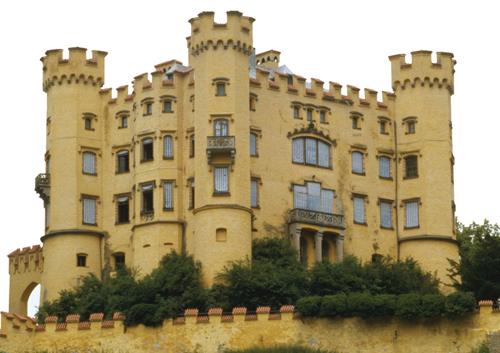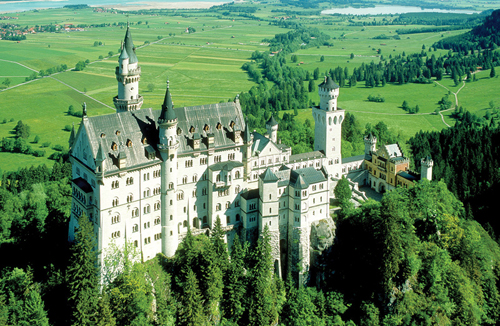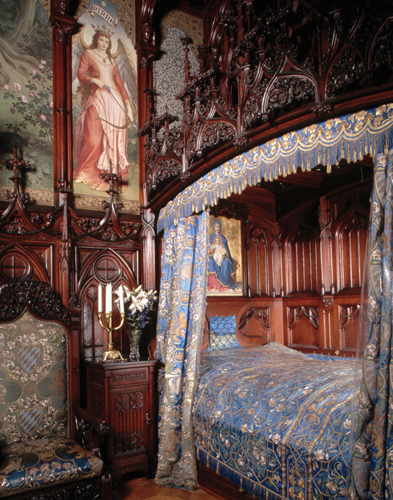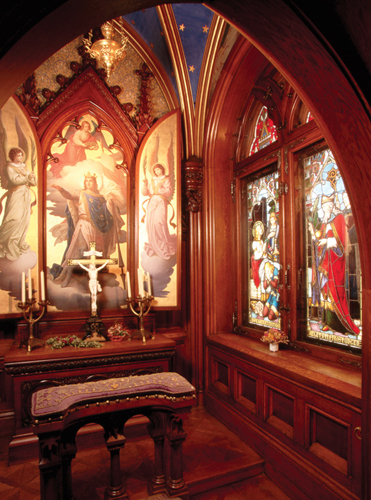An idealized vision of a knight’s castle on the
outside and a homage to Wagner’s operas on the inside, Neuschwanstein
was Ludwig II’s most ambitious project. During the same period, he
commissioned Linderhof and Herrenchiemsee, two castles in the French
style. More than 50 million visitors have admired these fairy-tale
castles since they were built by the shy and world-weary king. At
Neuschwanstein, in particular, there seems to be no low season. A
daytrip from Munich toward Füssen in the Schwangau is an unforgettable
experience.
Neuschwanstein Castle0 83 62 93 98 80
www.neuschwanstein.de
Tickets at Ticketcenter Hohenschwangau 0 83 62 93 08 30 Open Apr–Sep: 9am–6pm daily (ticket office hours 8am–5pm), Oct–Mar:10am–4pm daily (ticket office hours 9am–3pm) Closed 1 Jan; Shrove Tue; 24, 25 & 31 Dec Adm: €9 (reduced €8); combined admission with Hohenschwangau €17 (reduced €15) Call ahead to book a special tour held Wed for those in wheelchairs
|
|
Despite the medieval
ambience, Neuschwanstein is full of high-tech features from its era. The
dining room was equipped with a serving hatch and elevator that went up
three floors. The kitchen had warm running water and automatic roasting
spits. Forced-air central heating kept the rooms warm. Toilets were
fitted with an automatic flush mechanism. An electric intercom was used
to communicate with servants, and the second and third floors were
linked by a telephone.
|

Hohenschwangau in the hills below Neuschwanstein
|
Refreshments are available in the cafeteria located on the castle grounds; and there are several restaurants nearby.
|
|
|
Guided tours are mandatory; tickets show the tour number and precise time of entry.
|
|
|
Two alternatives to reaching the castle on foot are a bus service, or, for a romantic experience, a horse-drawn carriage.
|
|
|
To the left of Pöllat Gorge stood the ruins of two small castles. Ludwig II had Neuschwanstein built on the site of these ruins.
|
|
The Building The
foundation stone was laid in 1869, the gatehouse was completed in 1873,
and the castle in 1884. Work continued, with the king constantly
altering the plans, until his death in 1886. The keep and Ritterbad
(knight’s bath) were never completed.

Throne Hall Gold,
saints, and a touch of Byzantium: the throne hall is modelled in part
after Munich’s All Saints Church and the Hagia Sophia in Istanbul.
Originally, the throne was to stand – like an altar – in the apse.

Bedroom In
contrast to the romanticism of the living quarters, the bedroom was
designed in a Gothic style complete with elaborately carved oak
panelling. Scenes from Wagner’s Tristan and Isolde decorate the walls.

Chapel Altar and murals depict Ludwig IX, the beatified king of France and namesake of the fairy-tale king of Bavaria.

Study Ludwig’s
study is filled with pictures from Wagner’s opera Tannhäuser. On his
desk is a fanciful pen-and-ink set in the shape of Lohengrin. Minstrel’s Room Influenced
by the ceremonial hall of the Wartburg in Eisenach, this is the
castle’s largest room. The walls are decorated with scenes from the
legend of Parzival and his quest for the Holy Grail. Grotto Going
between the living room and study, visitors pass through a grotto,
where a small waterfall flowed during the king’s lifetime. The larger
Venus grotto, complete with an artificial lake, is located in the park
of Linderhof Castle (see Grotto of Venus). Dining Room Dishes
were transported in an elevator from the kitchen three stories below to
the dining room, where the shy king took most of his meals on his own.
Murals depict the tradition of the minstrel’s song. Winter Garden Adjoining the grotto, the winter garden affords a spectacular view of Allgäu through a large window. Hohenschwangau Ludwig
spent part of his childhood and youth in this summer palace, which is
located in wildly romantic scenery. His father, Maximilian II, restored
the palace fully in 1832. Hohenschwangau’s coat of arms bears a swan –
later often depicted as Lohengrin’s swan, which is a constantly
recurring motif throughout Neuschwanstein.
|